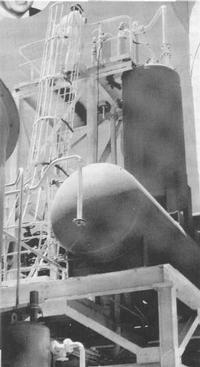


Chapter 9
I Introduction
II The Australian Chemical Industry
III Pharmaceuticals
IV Chemists In Other Industries
V The Dawn Of Modern Chemical Industry - High Pressure Synthesis
VI The Growth Of Synthetic Chemicals - Concentration, Rationalisation And International Links
VII Australian Industrial Chemical Research Laboratories
i Australian instrument inventions
ii Plant protection - overseas and in Australia
iii Successes in the laboratory but . . .
iv Drugs for sheep and cattle revisited Tetramisole - international success and local manufacture
v 'Promicide'* 'Grenade'* to control ticks
vi Technical service R&D
vii Industry/CSIRO/university collaboration
viii Australian entrepreneurs in modern chemistry
VIII The Plastics Industry
IX The Paint Industry
X Acknowledgements
References
Index
Search
Help
Contact us

Industry/CSIRO/university collaboration
Outside agriculture, both the public sector -CSIRO, the universities -and the private sector researchers sought projects of common interest and from time to time joint research projects resulted. Yet, nationally the interaction between public sector science and the manufacturing industries was less than either side would have wished. This was true even of the chemical industry, although it was the most research intensive of the major industries in Australia. The reasons are many, mostly historical, and have been subject of many papers. (See e.g. Manufacturing Industries of Australia, Symposium of the Australian Academy of Technological Sciences, 1981.)[110] Yet there were many examples of excellent collaborations. Just one of these was the 'Sirotherm' (CSIRO/ICI) project initiated by Dr. D. Weiss[111] of the CSIRO. CSIRO had found that water could be softened, that is undesired minerals removed, by ion exchange with a resin which bound the undesired mineral salt in the cold and released it again at elevated, but not excessively high temperatures. The concept held promise of wide industrial use, perhaps even desalination for agricultural purposes, if only the performance of the resins could be improved and costs reduced. A long, cordial and effective collaboration with virtual integration of the CSIRO and ICI teams resulted; many improvements[112] were made, but all proved marginal. ICI built a pilot plant (Fig. 23) and a full scale plant at its Osborne factory at a cost of over half a million dollars. It operated for some time but could not reach the level of reliability required of a plant on which the whole factory depended. The project reverted to the research stage and CSIRO, in collaboration with AUSTEP (Australian Technology Engineering and Processes Pty. Ltd.) and the Perth Water Board, developed ion exchange resins for a continuous water-softening process at a pilot plant in Leederville in Western Australia.
Another collaborative project between Monash University and ICI Australia{113,}[114] emanated from a Monash initiative and led to an Australian version of the Merrifield synthesis of peptides. The process was licensed overseas but was superseded by genetic engineering; it had a modest commercial outcome, 'Protapol', the forerunner of diagnostic aids commercialised by ICI in a new venture.
In the 1950s Melbourne University and CSR collaborated on a phosphate-based caries inhibiting compound; great hopes were held out for this project and it proceeded to the pilot plant and field testing stage. In the end almost insurmountable difficulties with registration and the advance of fluoridation forced closure of the venture.
Organisations in Australian Science at Work - AUSTEP Pty Ltd; Colonial Sugar Refining Company (C.S.R.); I.C.I. Australia Ltd; Monash University; Perth Water Board
People in Bright Sparcs - Weiss, Dr D.
 |
Australian Academy of Technological Sciences and Engineering |  |
© 1988 Print Edition pages 691 - 692, Online Edition 2000
Published by Australian Science and Technology Heritage Centre, using the Web Academic Resource Publisher
http://www.austehc.unimelb.edu.au/tia/658.html